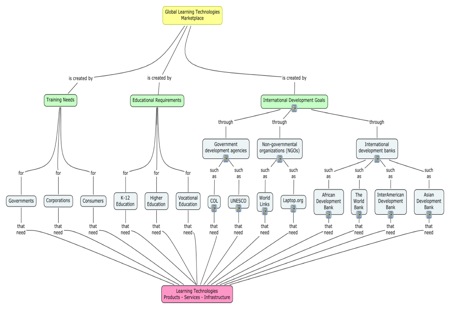The learning technologies marketplace in 2009 is dynamic entity, driven by technological change, economic pressures, and new possibilities. What began as an automated approach to traditional education and training practices is evolving in the direction of providing individuals, groups, and organizational entities with a set of technologies and services that expand our notions of access, choice, flexibility and mobility when we consider learning or training activities. There are also larger economic perspectives starting to influence how education whould be considered in the contexts of global competition and continuous change (see The Shaping Opportunity). Given these larger questions it is interesting to juxtapose the current world views of the Education and IT sectors regarding their most pressing priorities (see Educause Top Five Challenges and Gartner Group Top Five IT Drivers). They’re not on the same page…
While learning technologies have been seen to provide beneficial enhancements or improvements to traditional practices in the K-12, higher education, and in the corporate and industrial training sectors, they are also being seen by many governments in the developed world as important tools for modernizing government services and the workforce.
The concept map below shows one possible view of the learning technologies marketplace, with the business markets depicted on the left side of the map. We’ll be exploring the marketplace in the traditional business sense first, and then we’ll ask you to explore the emerging global marketplace as an activity in this module. We’ll also be exploring emerging markets in greater detail in subsequent modules of ETEC 522, for which you may find that other maps of the global learning marketplace are possible or resonate better with your needs or experience.
In Canada, the federal government has invested heavily in network infrastructure to make this country one of the most connected nations on earth. The Canadian government has also provided access to many government services, including training on their use, available as self-service applications that are accessible electronically by all citizens. This approach has also included programs and services to help reduce what has become known as the “digital divide” between citizens who have good access to Internet tools and services and those who are only now getting full access to Internet services in their communities.
In the developing world, learning technologies are now being seen as key components of the development pathway for emerging nations. Governments in these nations often work with international development agencies, non-governmental agencies (NGOs), and international development banks to plan the infrastructure for educational services that can be provided using learning technologies directed towards schools, community centres, and other locally appropriate sites for learning and training activities, and often into workplaces.
And, there are other dimensions to the learning technologies marketplace that introduce dynamics that can even be confounding or disruptive to the notion of a “marketplace.” The first of these is the identification of just who the “customer” is, and the requirement for learning technology companies to adjust their marketing and sales approaches to account for an academic environment in which the concept of customer may be at odds with the dominant cultural viewpoint.
Another dynamic that is beginning to have a strong influence on the education marketplace is the free and open source software movement. An example of the how the free and open source software movement is monitored and supported can be found at a UNESCO web site dedicated to this technology approach
http://www.unesco.org/webworld/portal_freesoft
Another site with a similar purpose that may also seem to be at odds with the notion of a “marketplace” is the Free Software Foundation.
We’ll look at the concept of the customer as it applies learning technologies, first. Following that we’ll explore “the cube,” a framework for analyzing learning technology markets that you can use as a component of your EVA tool kit. We’ll use the cube to practice our analytical skills as we examine some actual learning technology companies.
Later, in Module 6 we’ll take a deeper look at the free and open source software movement. However, if free and open source software is an interest of yours, you’ll be able to use the cube in activities for this module to map a learning technology organization such as Moodle (http://www.moodle.org) to the cube as an exploration of the cube’s utility in exploring the various facets of the global learning technology marketplace.
But first, let’s take a look at the concept of the customer and its multiple dimensions in the learning technologies sector.
